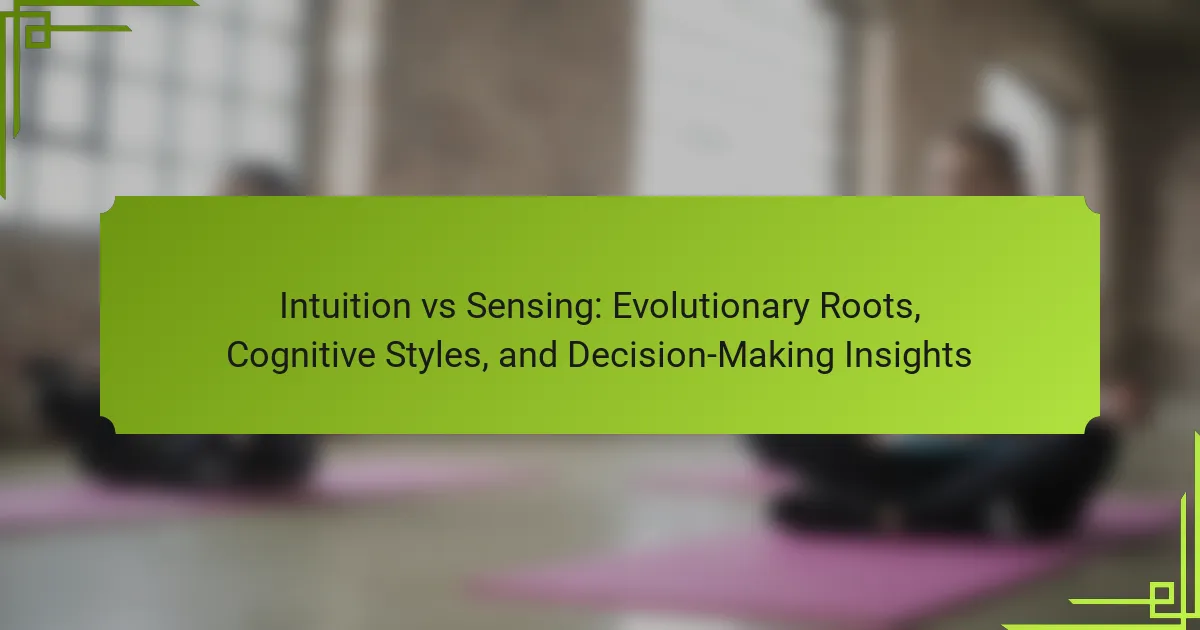Understanding the differences between intuition and sensing is crucial for effective decision-making. This article explores their evolutionary roots, highlighting their distinct cognitive styles. It examines how these styles influence information processing and decision-making strategies in various cultural contexts. Finally, it discusses practical applications for personal development and enhanced problem-solving skills.
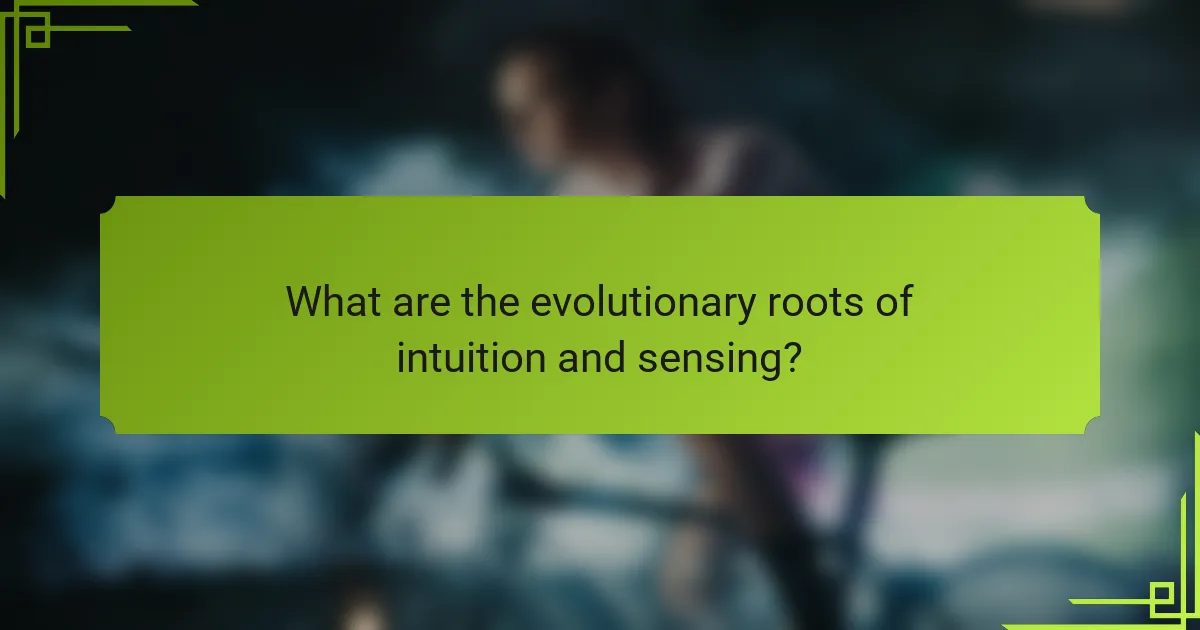
What are the evolutionary roots of intuition and sensing?
Intuition and sensing have distinct evolutionary roots that influence cognitive styles and decision-making. Intuition evolved as a rapid, subconscious process, aiding survival by allowing quick judgments in uncertain environments. Sensing, in contrast, developed as a method for gathering detailed information from the environment, promoting careful analysis and informed decisions. Both cognitive styles reflect adaptations to different survival needs, with intuition favouring speed and efficiency, while sensing emphasises accuracy and thoroughness. Understanding these roots provides insights into how individuals approach decision-making in various contexts.
How did early human survival shape cognitive styles?
Early human survival significantly influenced cognitive styles, particularly the balance between intuition and sensing. Intuitive thinkers often relied on quick, gut feelings to make decisions in uncertain environments, while sensing individuals focused on concrete data and immediate experiences. This dichotomy stems from evolutionary pressures where rapid decision-making was vital for survival. As a result, modern cognitive styles reflect these adaptive strategies, with intuition aiding in fast responses to threats and sensing enhancing awareness of the environment. Understanding this evolutionary background provides insights into current decision-making processes, emphasising the interplay between instinct and analysis in human cognition.
What role did intuition play in ancestral decision-making?
Intuition played a crucial role in ancestral decision-making by providing rapid assessments based on instinct and experience. This cognitive style allowed early humans to make quick choices in uncertain environments, enhancing survival. Intuitive decisions often relied on emotional and sensory cues, enabling individuals to react swiftly to threats or opportunities. As a result, intuition became a unique attribute of human cognition, fostering adaptability and resilience in evolving contexts.
How does sensing relate to environmental awareness in evolution?
Sensing enhances environmental awareness by facilitating immediate responses to stimuli, crucial for survival. In evolutionary terms, organisms developed heightened sensory perceptions to navigate their surroundings, identify threats, and locate resources. This adaptive trait supports decision-making processes, allowing individuals to react swiftly to environmental changes. For example, animals with acute sensing abilities can better evade predators or find food, thereby increasing their chances of survival and reproduction.
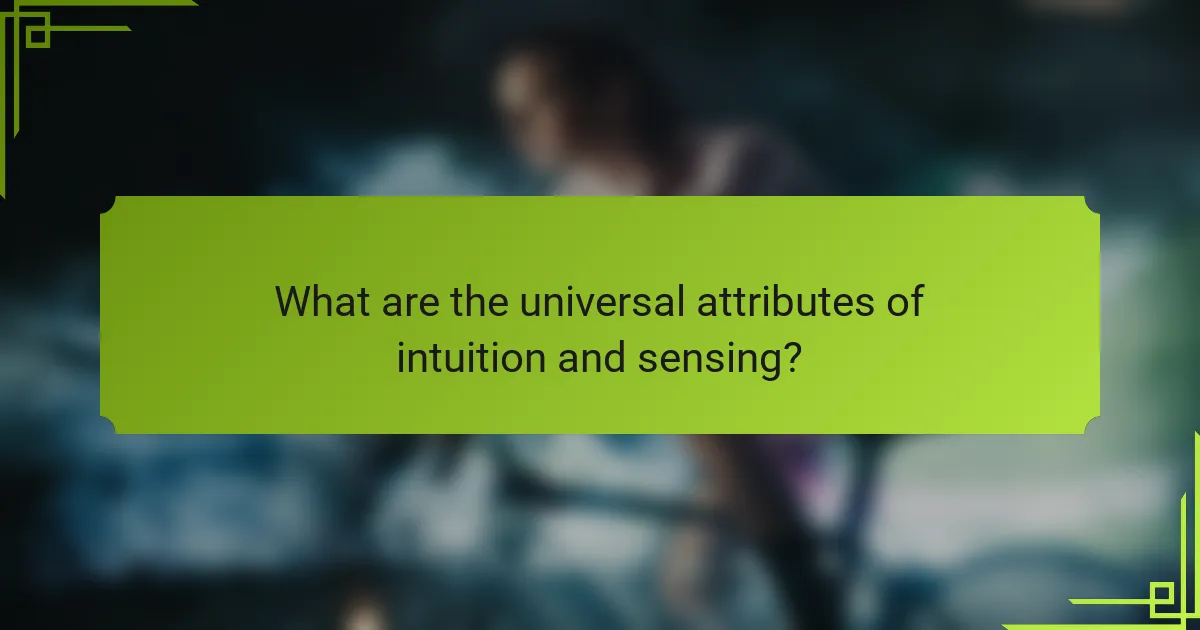
What are the universal attributes of intuition and sensing?
Intuition and sensing share universal attributes that influence cognitive styles and decision-making. Both involve perception, but intuition focuses on patterns and possibilities, while sensing emphasises concrete details and present realities.
Root attributes include cognitive processing styles, where intuition leverages abstract thinking and sensing relies on factual information. Unique attributes involve the emotional resonance of intuition versus the practicality of sensing. Rare attributes may include the adaptability of intuition in ambiguous situations compared to the structured approach of sensing in routine tasks.
Understanding these attributes enhances insights into human behaviour and decision-making processes.
How do intuition and sensing influence perception?
Intuition and sensing shape perception by influencing how individuals process information. Intuitive individuals often rely on gut feelings and abstract patterns, while those who sense focus on concrete details and immediate experiences. This distinction impacts decision-making, as intuition fosters creativity and quick judgments, whereas sensing promotes thorough analysis and cautious choices. Understanding these cognitive styles reveals insights into personal preferences and evolutionary roots in human behaviour.
What cognitive processes are shared between intuition and sensing?
Intuition and sensing share cognitive processes that involve perception and information processing. Both rely on immediate experiences and environmental cues to guide decision-making.
Intuition often synthesises information rapidly, drawing from past experiences and subconscious knowledge. Sensing, on the other hand, focuses on present realities, emphasising concrete data and sensory input.
These cognitive styles influence how individuals approach problem-solving. Intuitive thinkers may rely on gut feelings, while sensing individuals prefer factual analysis.
Understanding these shared processes can enhance teamwork and communication by recognising differing decision-making styles. This awareness can lead to more effective collaboration in various contexts.
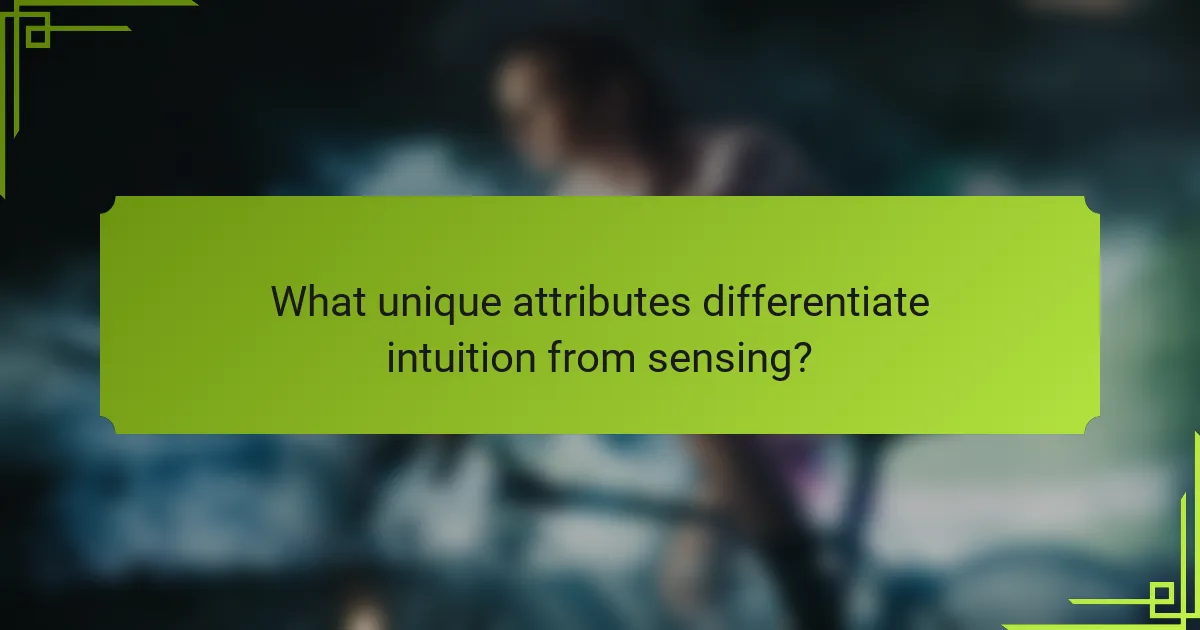
What unique attributes differentiate intuition from sensing?
Intuition and sensing differ primarily in their cognitive styles and information processing. Intuition relies on abstract patterns and future possibilities, while sensing focuses on concrete details and present realities. Unique attributes include intuition’s emphasis on holistic understanding and sensing’s preference for empirical data.
How does intuition manifest in problem-solving scenarios?
Intuition often manifests in problem-solving as an immediate understanding or insight without conscious reasoning. It allows individuals to make quick decisions based on past experiences and internal cues. Intuitive problem-solving is often contrasted with analytical approaches, highlighting different cognitive styles. Research indicates that intuition can enhance decision-making efficiency, especially in complex scenarios where data is incomplete. This evolutionary trait may have developed to aid survival by enabling rapid responses to environmental challenges.
In what ways does sensing enhance detail-oriented tasks?
Sensing enhances detail-oriented tasks by improving focus, perception, and accuracy. It allows individuals to notice subtle cues and nuances, which leads to better performance in tasks requiring precision. Enhanced sensory awareness contributes to effective decision-making and problem-solving. This cognitive style fosters an environment where details are prioritised, leading to higher quality outcomes.
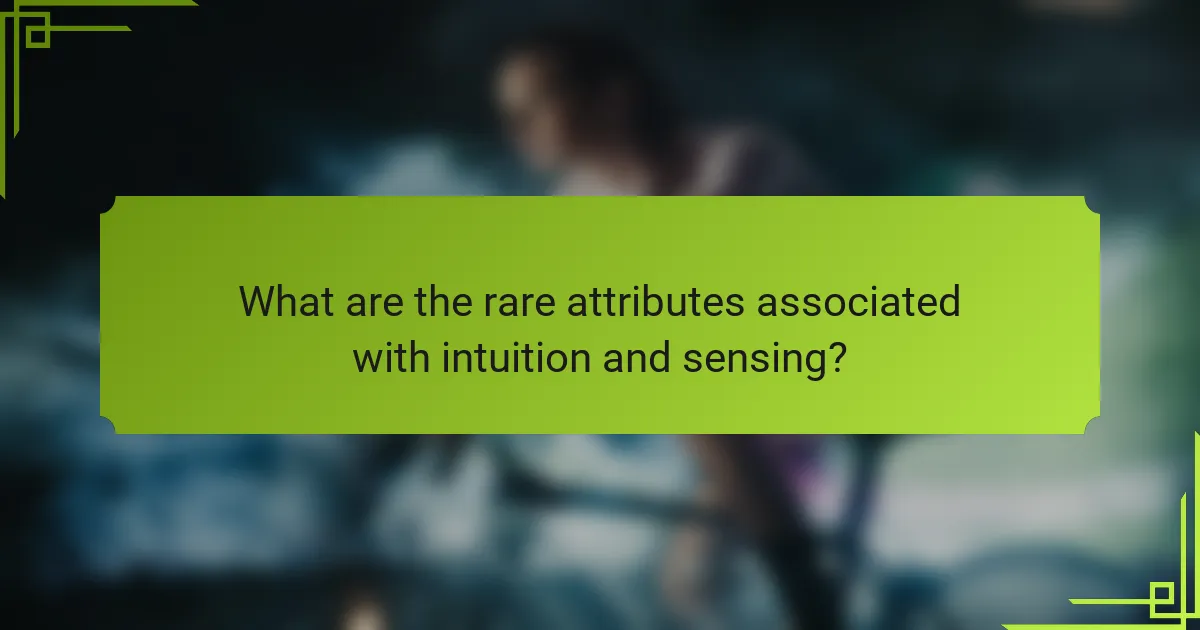
What are the rare attributes associated with intuition and sensing?
Intuition and sensing have rare attributes that reveal their unique cognitive styles. Intuition often involves abstract thinking and future-oriented insights, while sensing focuses on concrete details and present realities. Rarely, individuals exhibit a high degree of adaptability, allowing them to switch between these styles based on context. Additionally, intuition may be linked to creativity and innovation, whereas sensing can enhance observational skills and practical problem-solving. These distinctions illustrate the nuanced interplay between cognitive approaches in decision-making.
How do intuition and sensing affect creativity and innovation?
Intuition enhances creativity by allowing individuals to make quick connections and generate novel ideas, while sensing relies on data and past experiences. Intuitive thinkers often explore possibilities and innovate, whereas sensing types focus on practical solutions. This cognitive style difference influences decision-making processes, leading to diverse creative outcomes. Intuitive individuals may thrive in unstructured environments, fostering innovation, while sensing individuals excel in structured settings, ensuring feasibility. Balancing both styles can optimise creativity and innovation.
What unique decision-making scenarios highlight these cognitive styles?
Intuition and sensing lead to distinct decision-making scenarios. Intuitive thinkers often excel in situations requiring quick, abstract insights, while sensing individuals thrive in detail-oriented, data-driven contexts.
Intuitive decision-making may involve innovative problem-solving, such as envisioning future trends or creative solutions. In contrast, sensing decisions are grounded in concrete facts, making them effective in logistical planning or risk assessment.
For example, an intuitive leader might pivot a business strategy based on emerging market signals, while a sensing manager would analyse historical performance data to make operational adjustments. Each cognitive style reflects unique evolutionary adaptations, influencing their approach to complex decisions.
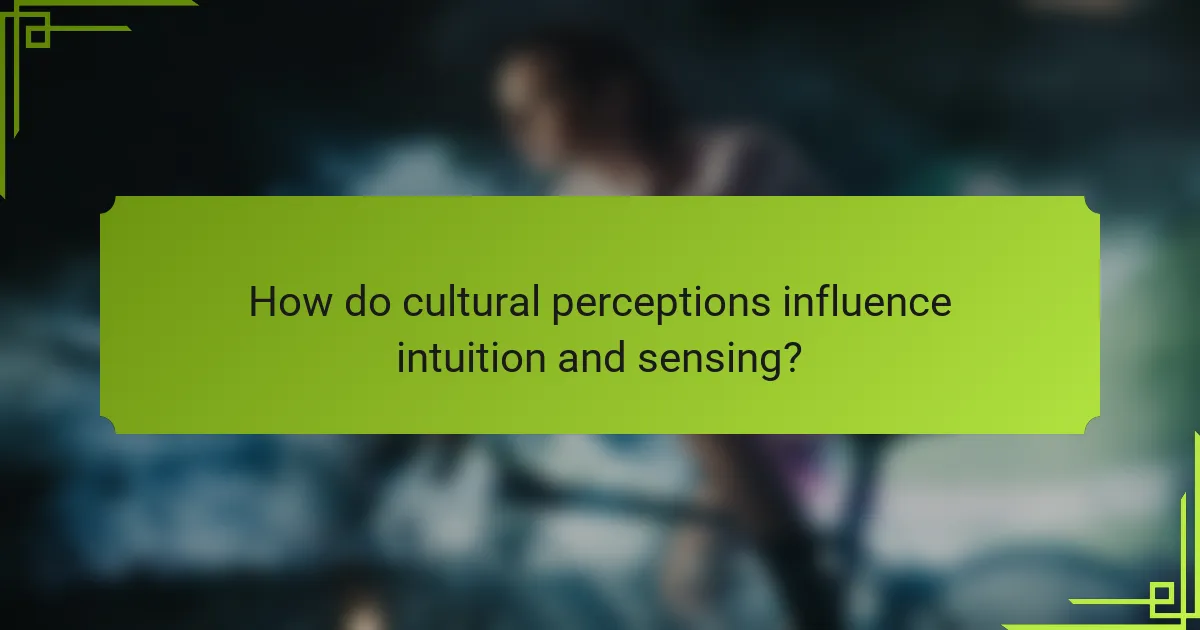
How do cultural perceptions influence intuition and sensing?
Cultural perceptions significantly shape intuition and sensing by influencing how individuals interpret experiences and make decisions. Cultural backgrounds dictate cognitive styles, which affect the reliance on intuitive versus sensory information. For example, collectivist cultures may prioritise group consensus, enhancing intuitive decision-making. In contrast, individualistic cultures often emphasise analytical thinking, favouring sensory data. This dynamic illustrates how cultural context moulds cognitive processes, impacting overall decision-making strategies.
What are the implications of intuition and sensing in UK society?
Intuition and sensing significantly influence decision-making in UK society. Intuitive individuals often prioritise abstract ideas and future possibilities, while sensing individuals focus on concrete facts and present realities. This cognitive divide impacts various sectors, including business and education. For example, in business, intuitive leaders may embrace innovation, while sensing leaders may emphasise stability. Understanding these cognitive styles can enhance collaboration and improve outcomes across diverse fields.
How do gender differences affect the use of intuition and sensing?
Gender differences significantly influence the use of intuition and sensing in decision-making. Research indicates that women often exhibit stronger intuitive capabilities, while men may rely more on sensing and analytical approaches.
Studies suggest that these tendencies arise from evolutionary roles, where women developed intuition for social cohesion and nurturing, while men focused on immediate, sensory information for survival. This divergence results in varied cognitive styles, with women favouring holistic perspectives and men emphasising detail-oriented analysis.
In practical applications, these differences affect group dynamics and problem-solving strategies. Women may prioritise emotional insights, leading to collaborative decisions, whereas men might pursue direct, data-driven outcomes. Recognising these distinctions can enhance communication and effectiveness in mixed-gender teams.
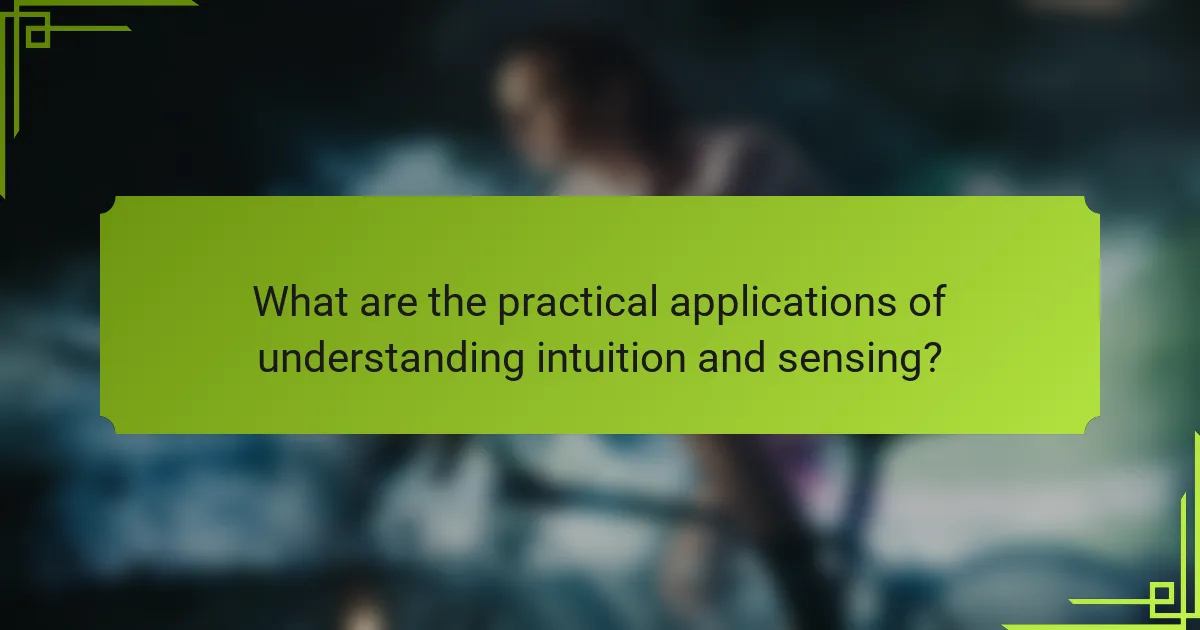
What are the practical applications of understanding intuition and sensing?
Understanding intuition and sensing enhances decision-making and personal development. Intuition allows quick judgments based on experience, while sensing emphasises data and facts. Both cognitive styles can be applied in various fields, including business, education, and psychology. For example, leaders who understand these concepts can tailor their strategies to leverage team strengths, fostering innovation and efficiency. Additionally, individuals can improve their problem-solving skills by recognising when to trust their instincts versus relying on analytical thinking. This duality promotes balanced decision-making and adaptability in complex situations.
What strategies can improve decision-making based on cognitive styles?
Utilising strategies that align with cognitive styles can significantly enhance decision-making. For individuals who favour intuition, fostering a creative environment encourages innovative solutions. In contrast, those who prefer sensing benefit from structured data and clear guidelines. Tailoring approaches based on these cognitive styles leads to more effective outcomes. Engaging in collaborative discussions can also bridge the gap between differing styles, promoting a comprehensive decision-making process.
What common mistakes should be avoided in relying on intuition or sensing?
Relying on intuition or sensing can lead to several common mistakes. Overconfidence in gut feelings often results in ignoring critical data. Failing to validate intuitive insights with analytical reasoning can skew decision-making. Additionally, allowing emotions to influence intuition may cloud judgment, leading to poor outcomes. Lastly, neglecting diverse perspectives can limit the effectiveness of intuitive decisions.
How can individuals leverage their cognitive style for personal growth?
Individuals can leverage their cognitive style by recognising their intuitive or sensing preferences and adapting strategies accordingly. Intuitive thinkers excel in abstract concepts and future possibilities, while sensing individuals focus on concrete details and present realities. By understanding these styles, individuals can enhance decision-making and personal growth. For instance, intuitive individuals may benefit from setting long-term goals, while sensing individuals should prioritise practical steps. This tailored approach can lead to improved self-awareness and optimised learning experiences.
